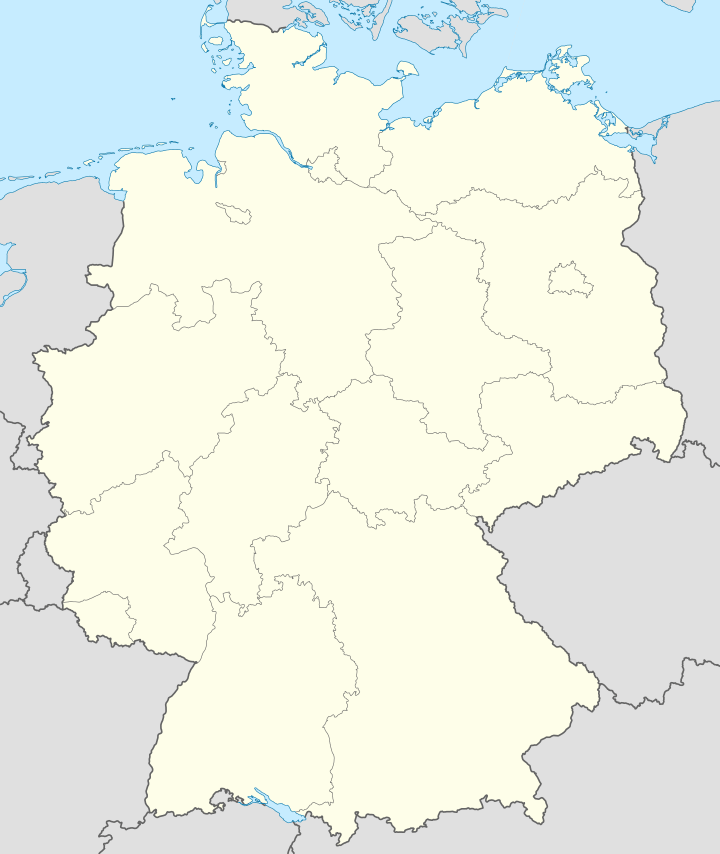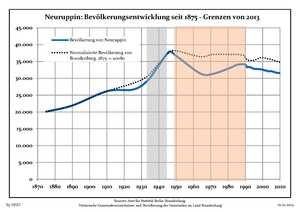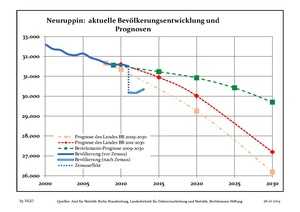Neuruppin
| Neuruppin | ||
|---|---|---|
|
Holy Trinity Church | ||
| ||
 Neuruppin | ||
Location of Neuruppin within Ostprignitz-Ruppin district  | ||
| Coordinates: 52°55′59″N 12°48′00″E / 52.93306°N 12.80000°ECoordinates: 52°55′59″N 12°48′00″E / 52.93306°N 12.80000°E | ||
| Country | Germany | |
| State | Brandenburg | |
| District | Ostprignitz-Ruppin | |
| Government | ||
| • Mayor | Jens-Peter Golde (Pro Ruppin) | |
| Area | ||
| • Total | 303.32 km2 (117.11 sq mi) | |
| Population (2012-12-31)[1] | ||
| • Total | 30,162 | |
| • Density | 99/km2 (260/sq mi) | |
| Time zone | CET/CEST (UTC+1/+2) | |
| Postal codes | 16816, 16818, 16827 | |
| Dialling codes | 03391, 033925, 033929, 033932, 033933 | |
| Vehicle registration | OPR, KY, NP, WK | |
| Website | www.neuruppin.de | |
Neuruppin (German pronunciation: [nɔʏʁʊˈpiːn]) is a town in Brandenburg, Germany, the administrative seat of Ostprignitz-Ruppin district. It is the birthplace of the novelist Theodor Fontane (1819–1898) and therefore also referred to as Fontanestadt. A garrison town since 1688 and largely rebuilt in a Neoclassical style after a devastating fire in 1787, Neuruppin has the reputation of being "the most Prussian of all Prussian towns".
Geography
The town is located on the shore of the Ruppiner See, a lake traversed by the Rhin river, about 60 km (37 mi) northwest of Berlin. In the north, the hilly landscape of Ruppin Switzerland stretches up to the Rheinsberg Lake Region and the border with Mecklenburg-Vorpommern. It is part of the Stechlin-Ruppiner Land Nature Park.
After several incorporations in 1993, Neuruppin today is one of Germany's largest municipalities by area.
History
The shores of Ruppiner See were settled since the Stone Age; in the 9th century AD, Poggenwerder Island was the site of a Slavic gord (burgwall), probably built by Polabian Zamizi tribes. The castle was possibly slighted during the Wendish Crusade of 1147 and about 1200 a lowland castle was erected on an opposite peninsula, which from 1214 served as the residence of the Lords of Ruppin. Their lordship remained an immediate Imperial estate until its final incorporation into the neighbouring Margraviate of Brandenburg in 1524.

The name Neuruppin means "New Ruppin", as the original settlement of Ruppin (later Alt Ruppin, "Old Ruppin") was located around the castle on the north-eastern shore of the Ruppiner See. In the early 13th century, when the settlement became too small for the growing population, Neuruppin on the western shore of the lake was established by the Lords of Lindow-Ruppin. First mentioned in a 1238 deed, it became the first establishment of the Dominican Order between the Elbe and Oder rivers, when the local noble Wichmann von Arnstein founded Neuruppin Abbey in 1246. Today only the monastery church is still standing. Since the Protestant Reformation it is called St Trinitatis. Neuruppin received town privileges on 9 March 1256; town walls were erected and completed until the 15th century.
In 1524 Ruppin Land was finally seized as a reverted fief by the Hohenzollern elector Joachim I Nestor of Brandenburg. The monastery was secularised in the course of the Reformation and its premises ceded to the Neuruppin citizens. The town was ravaged by the Thirty Years' War, from about 1685 French Huguenot refugees settled here. In 1688 Neuruppin became a Brandenburg-Prussian garrison town.
After a disastrous fire in 1787 the Neo-Classicism of the rebuilt town's buildings characterise its townscape to the present day. It remained a garrison town until the late 20th century, since Soviet (resp. Russian) troops were stationed here until 1993; during this time there were as many Soviet soldiers as inhabitants in Neuruppin.
Demography
-

Development of Population since 1875 within the Current Boundaries (Blue Line: Population; Dotted Line: Comparison to Population Development of Brandenburg state; Grey Background: Time of Nazi rule; Red Background: Time of Communist rule)
-

Recent Population Development (Blue Line) and Forecasts
Notable people
The novelist Theodor Fontane, the architect Karl Friedrich Schinkel, the lieutenant colonel Otto Friedrich Ferdinand von Görschen, the general Hermann Hoth, the serial killer Carl Großmann and the actor Klaus Schwarzkopf were born in Neuruppin. The architect Joachim Ludwig Schultheiss von Unfriedt was possibly from Altruppin.
Frederick the Great lived in Neuruppin in his years as crown prince of Prussia. Prussian general and military strategist Carl Phillip Gottlieb von Clausewitz also resided in Neuruppin for a few years.
Photo gallery
-

Schinkel statue
-

Statue by Matthias Zágon Hohl-Stein
-

Manor house of the family Gentz in Gentzrode
-

Ruppiner See (Ruppin lake) with monastery church towers]]
-

″Sabine" in Binenwalde
-

Neumühle
-

Former fire extinguisher factory
References
- ↑ "Bevölkerung im Land Brandenburg nach amtsfreien Gemeinden, Ämtern und Gemeinden 31. Dezember 2012 (XLS-Datei; 83 KB) (Einwohnerzahlen auf Grundlage des Zensus 2011)". Amt für Statistik Berlin-Brandenburg (in German). 31 December 2012.
External links
![]() Media related to Neuruppin at Wikimedia Commons
Media related to Neuruppin at Wikimedia Commons
| ||||||||


